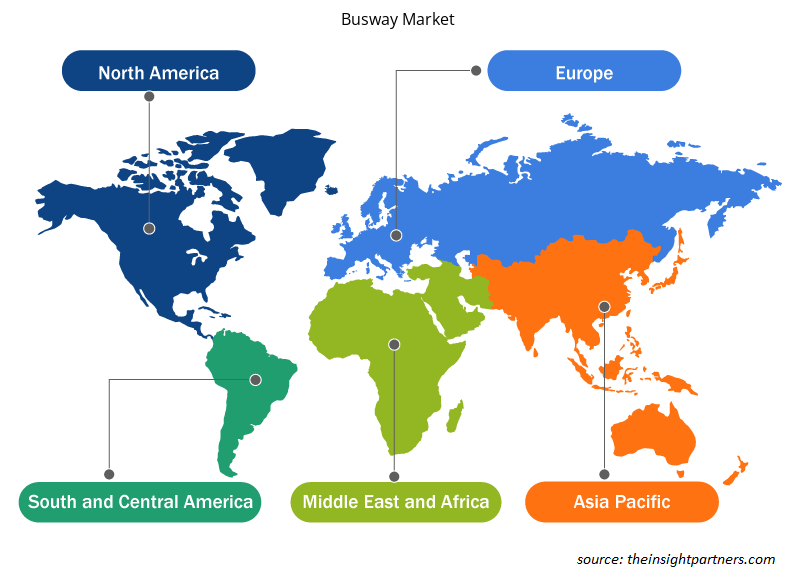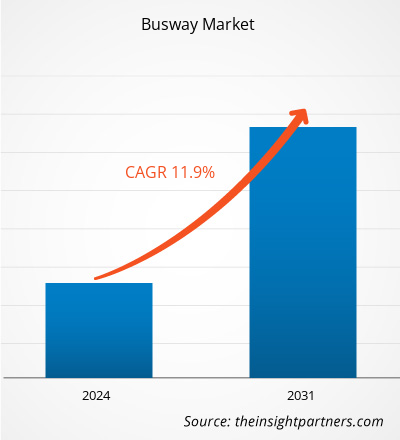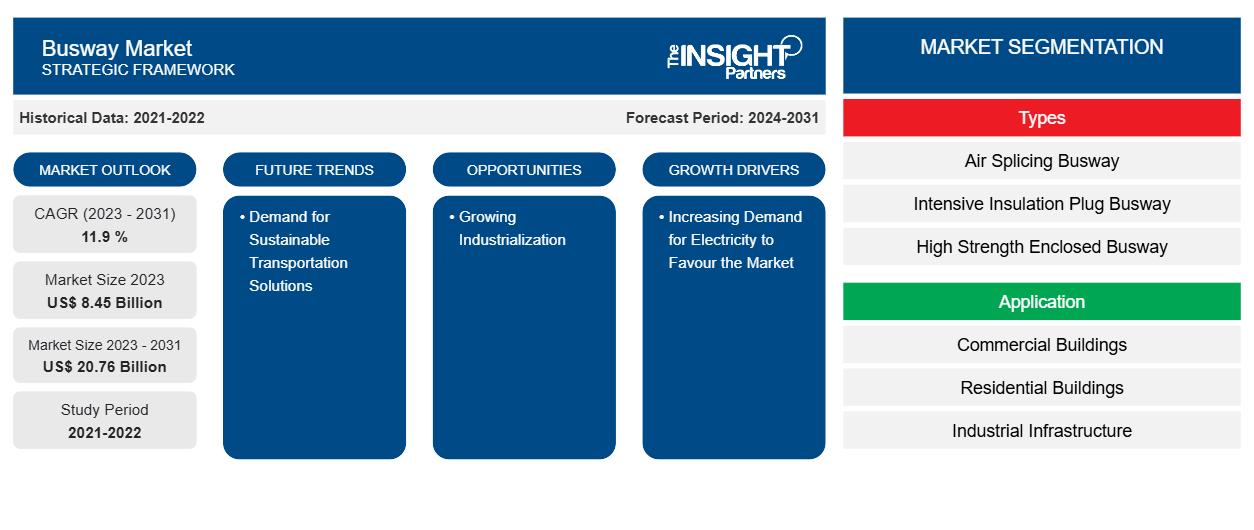La taille du marché des voies réservées aux bus devrait atteindre 20,76 milliards de dollars américains d'ici 2031, contre 8,45 milliards de dollars américains en 2023. Le marché devrait enregistrer un TCAC de 11,9 % en 2023-2031. La demande croissante en électricité et l'industrialisation croissante devraient rester les principales tendances du marché des voies réservées aux bus.
Analyse du marché des voies réservées aux bus
Différentes tendances de croissance sont observées dans différentes régions de ce secteur. Les marchés développés d'Amérique du Nord (NA) et d'Europe (ELI) représentent une part importante de la part de marché mondiale. Cependant, les pays en développement dans des régions comme l'Asie-Pacifique (APAC), le Moyen-Orient et l'Afrique (ME), l'Afrique et l'Amérique du Sud (SAM) connaissent une croissance rapide en raison de divers facteurs tels que le besoin d'électrification et la croissance de nouvelles industries et infrastructures. L'adoption des busway devrait augmenter rapidement dans les années à venir en raison de l'expansion des réseaux électriques et du développement des centrales d'énergie renouvelable à l'échelle mondiale.
Aperçu du marché des voies réservées aux bus
La National Electrical Manufacturers Association (NEMA) définit une barre omnibus comme un système de distribution électrique préfabriqué composé de longueurs droites, de raccords, d'appareils et d'accessoires, le tout enfermé dans un boîtier de protection. Les barres omnibus transportent l'énergie et la relient à des équipements électriques tels que des transformateurs, des panneaux de distribution et des appareillages de commutation . Dans les applications commerciales et industrielles, une barre omnibus est un excellent substitut aux câbles et aux conduits car elle est plus facile à remplacer, moins coûteuse à installer et nécessite moins de travail de configuration, en particulier dans les scénarios où les positions de charge sont susceptibles de varier.
Personnalisez ce rapport en fonction de vos besoins
Vous bénéficierez d'une personnalisation gratuite de n'importe quel rapport, y compris de certaines parties de ce rapport, d'une analyse au niveau des pays, d'un pack de données Excel, ainsi que de superbes offres et réductions pour les start-ups et les universités.
-
Obtenez les principales tendances clés du marché de ce rapport.Cet échantillon GRATUIT comprendra une analyse de données, allant des tendances du marché aux estimations et prévisions.
Moteurs et opportunités du marché des voies réservées aux bus
La demande croissante d’électricité favorise le marché.
L’utilisation de l’électricité a augmenté au cours des dernières décennies et est désormais essentielle aux économies modernes. En raison de l’augmentation du revenu disponible, cette demande devrait augmenter dans les années à venir. L’augmentation de la consommation d’électricité a entraîné une augmentation de l’utilisation de l’électricité dans les industries consommatrices finales et dans l’automobile. Il existe deux schémas géographiques différents pour la demande d’électricité. Les gains d’efficacité énergétique contrebalancent la croissance future associée à l’électrification et à la numérisation accrues dans les économies avancées.
Industrialisation croissante
L'industrialisation croissante conduit au développement de nouvelles usines et unités de fabrication, qui nécessitent une infrastructure électrique robuste pour alimenter les machines et les équipements, créant une demande de systèmes de voies blindées pour distribuer efficacement l'électricité.busway systems to efficiently distribute electricity.
Analyse de segmentation du rapport sur le marché des voies réservées aux bus Market Report Segmentation Analysis
Les segments clés qui ont contribué à l’élaboration de l’analyse du marché des busways sont les types et les applications.busway market analysis are types and applications.
- En fonction des types, le marché des barres omnibus est divisé en barres omnibus à épissure aérienne (BMC), barres omnibus à bouchons d'isolation intensive (CMC), barres omnibus fermées à haute résistance (CFW) et autres.busway market is divided into air splicing busways (BMC), intensive insulation plugs busways (CMC), high-strength enclosed busways (CFW), and others).
- En termes d’application, le marché est segmenté en bâtiments commerciaux, bâtiments résidentiels, infrastructures industrielles et autres.
Analyse des parts de marché des busway par zone géographique Market Share Analysis by Geography
Français La portée géographique du rapport sur le marché des voies réservées aux bus est principalement divisée en cinq régions : Amérique du Nord, Asie-Pacifique, Europe, Moyen-Orient et Afrique, et Amérique du Sud/Amérique du Sud et centrale. L'Amérique du Nord a dominé le marché des voies réservées aux bus. Les tendances d'adoption de haute technologie dans diverses industries de la région nord-américaine ont alimenté la croissance du marché des voies réservées aux bus. De plus, l'accent mis sur la recherche et le développement dans les économies développées des États-Unis et du Canada oblige les acteurs nord-américains à introduire sur le marché des solutions technologiquement avancées. En outre, les États-Unis comptent de nombreux acteurs du marché des voies réservées aux bus qui se concentrent de plus en plus sur le développement de solutions innovantes. Tous ces facteurs contribuent à la croissance du marché des voies réservées aux bus dans la région.busway market report is mainly divided into five regions: North America, Asia Pacific, Europe, Middle East & Africa, and South America/South & Central America. North America has dominated the busway market. High technology adoption trends in various industries in the North American region have fuelled the growth of the busway market. Moreover, a strong emphasis on research and development in the developed economies of the US and Canada is forcing the North American players to bring technologically advanced solutions into the market. In addition, the US has many busway market players who have been increasingly focusing on developing innovative solutions. All these factors contribute to the region's growth of the busway market.
Aperçu régional du marché des voies réservées aux bus
Les tendances et facteurs régionaux influençant le marché Busway tout au long de la période de prévision ont été expliqués en détail par les analystes d'Insight Partners. Cette section traite également des segments et de la géographie du marché Busway en Amérique du Nord, en Europe, en Asie-Pacifique, au Moyen-Orient et en Afrique, ainsi qu'en Amérique du Sud et en Amérique centrale.

- Obtenez les données régionales spécifiques au marché des voies réservées aux bus
Portée du rapport sur le marché des voies réservées aux bus
| Attribut de rapport | Détails |
|---|---|
| Taille du marché en 2023 | 8,45 milliards de dollars américains |
| Taille du marché d'ici 2031 | 20,76 milliards de dollars américains |
| Taux de croissance annuel composé mondial (2023-2031) | 11,9 % |
| Données historiques | 2021-2022 |
| Période de prévision | 2024-2031 |
| Segments couverts |
Par types
|
| Régions et pays couverts |
Amérique du Nord
|
| Leaders du marché et profils d'entreprises clés |
|
Densité des acteurs du marché des busway : comprendre son impact sur la dynamique commerciale
Le marché des busway connaît une croissance rapide, stimulée par la demande croissante des utilisateurs finaux en raison de facteurs tels que l'évolution des préférences des consommateurs, les avancées technologiques et une plus grande sensibilisation aux avantages du produit. À mesure que la demande augmente, les entreprises élargissent leurs offres, innovent pour répondre aux besoins des consommateurs et capitalisent sur les tendances émergentes, ce qui alimente davantage la croissance du marché.
La densité des acteurs du marché fait référence à la répartition des entreprises ou des sociétés opérant sur un marché ou un secteur particulier. Elle indique le nombre de concurrents (acteurs du marché) présents sur un marché donné par rapport à sa taille ou à sa valeur marchande totale.
Les principales entreprises opérant sur le marché des Busway sont :
- Schneider Electric
- Siemens
- Eaton
- Câbles et systèmes LS
- Prise d'alimentation Busduct Sdn. Bhd.
- ABB
Avis de non-responsabilité : les sociétés répertoriées ci-dessus ne sont pas classées dans un ordre particulier.

- Obtenez un aperçu des principaux acteurs clés du marché Busway
Actualités et développements récents du marché des voies réservées aux bus
Le marché des voies réservées aux bus est évalué en collectant des données qualitatives et quantitatives après des recherches primaires et secondaires, qui comprennent d'importantes publications d'entreprise, des données d'association et des bases de données. Voici une liste des évolutions du marché :
- En juin 2021, la société de gestion d'énergie Eaton a annoncé avoir finalisé l'acquisition d'une participation de 50 % dans l'activité de busway de Jiangsu YiNeng Electric, qui fabrique et commercialise des produits de busway en Chine et a réalisé un chiffre d'affaires de 60 millions de dollars américains en 2020.
(Source : Eaton, Communiqué de presse, 2021)
Rapport sur le marché des voies réservées aux bus et livrables
Le rapport « Busway Market Size and Forecast (2021-2031) » fournit une analyse détaillée du marché couvrant les domaines ci-dessous :
- Taille du marché et prévisions aux niveaux mondial, régional et national pour tous les segments de marché clés couverts par le périmètre
- Dynamique du marché, comme les facteurs moteurs, les contraintes et les opportunités clés
- Principales tendances futures
- Analyse détaillée des cinq forces de PEST/Porter et SWOT
- Analyse du marché mondial et régional couvrant les principales tendances du marché, les principaux acteurs, les réglementations et les développements récents du marché
- Analyse du paysage industriel et de la concurrence couvrant la concentration du marché, l'analyse de la carte thermique, les principaux acteurs et les développements récents
- Profils d'entreprise détaillés
- Analyse historique (2 ans), année de base, prévision (7 ans) avec TCAC
- Analyse PEST et SWOT
- Taille du marché Valeur / Volume - Mondial, Régional, Pays
- Industrie et paysage concurrentiel
- Ensemble de données Excel
Rapports récents
Témoignages
Raison d'acheter
- Prise de décision éclairée
- Compréhension de la dynamique du marché
- Analyse concurrentielle
- Connaissances clients
- Prévisions de marché
- Atténuation des risques
- Planification stratégique
- Justification des investissements
- Identification des marchés émergents
- Amélioration des stratégies marketing
- Amélioration de l'efficacité opérationnelle
- Alignement sur les tendances réglementaires























 Obtenez un échantillon gratuit pour - Marché Busway
Obtenez un échantillon gratuit pour - Marché Busway